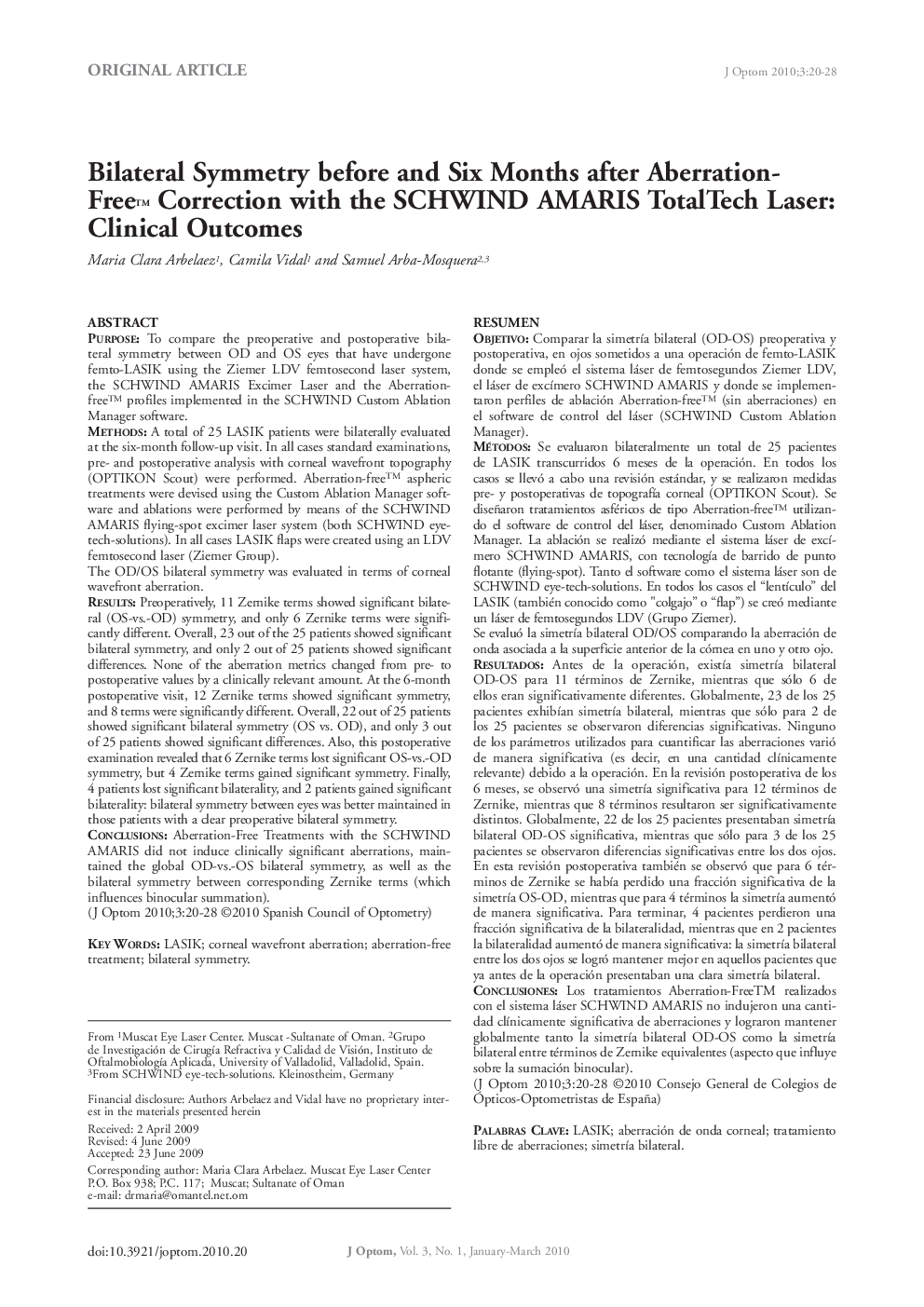| کد مقاله | کد نشریه | سال انتشار | مقاله انگلیسی | نسخه تمام متن |
|---|---|---|---|---|
| 2695189 | 1143729 | 2010 | 9 صفحه PDF | دانلود رایگان |

PurposeTo compare the preoperative and postoperative bilateral symmetry between OD and OS eyes that have undergone femto-LASIK using the Ziemer LDV femtosecond laser system, the SCHWIND AMARIS Excimer Laser and the Aberrationfree™ profiles implemented in the SCHWIND Custom Ablation Manager software.MethodsA total of 25 LASIK patients were bilaterally evaluated at the six-month follow-up visit. In all cases standard examinations, pre- and postoperative analysis with corneal wavefront topography (OPTIKON Scout) were performed. Aberration-free™ aspheric treatments were devised using the Custom Ablation Manager software and ablations were performed by means of the SCHWIND AMARIS flying-spot excimer laser system (both SCHWIND eyetech- solutions). In all cases LASIK flaps were created using an LDV femtosecond laser (Ziemer Group).The OD/OS bilateral symmetry was evaluated in terms of corneal wavefront aberration.ResultsPreoperatively, 11 Zernike terms showed significant bilateral (OS-vs.-OD) symmetry, and only 6 Zernike terms were significantly different. Overall, 23 out of the 25 patients showed significant bilateral symmetry, and only 2 out of 25 patients showed significant differences. None of the aberration metrics changed from pre- to postoperative values by a clinically relevant amount. At the 6-month postoperative visit, 12 Zernike terms showed significant symmetry, and 8 terms were significantly different. Overall, 22 out of 25 patients showed significant bilateral symmetry (OS vs. OD), and only 3 out of 25 patients showed significant differences. Also, this postoperative examination revealed that 6 Zernike terms lost significant OS-vs.-OD symmetry, but 4 Zernike terms gained significant symmetry. Finally, 4 patients lost significant bilaterality, and 2 patients gained significant bilaterality: bilateral symmetry between eyes was better maintained in those patients with a clear preoperative bilateral symmetry.ConclusionsAberration-Free Treatments with the SCHWIND AMARIS did not induce clinically significant aberrations, maintained the global OD-vs.-OS bilateral symmetry, as well as the bilateral symmetry between corresponding Zernike terms (which influences binocular summation).
ResumenObjetivoComparar la simetría bilateral (OD-OS) preoperativa y postoperativa, en ojos sometidos a una operación de femto-LASIK donde se empleó el sistema láser de femtosegundos Ziemer LDV, el láser de excímero SCHWIND AMARIS y donde se implementaron perfiles de ablación Aberration-free™ (sin aberraciones) en el software de control del láser (SCHWIND Custom Ablation Manager).MétodosSe evaluaron bilateralmente un total de 25 pacientes de LASIK transcurridos 6 meses de la operación. En todos los casos se llevó a cabo una revisión estándar, y se realizaron medidas pre- y postoperativas de topografía corneal (OPTIKON Scout). Se diseñaron tratamientos asféricos de tipo Aberration-free™ utilizando el software de control del láser, denominado Custom Ablation Manager. La ablación se realizó mediante el sistema láser de excímero SCHWIND AMARIS, con tecnología de barrido de punto flotante (flying-spot). Tanto el software como el sistema láser son de SCHWIND eye-tech-solutions. En todos los casos el “lentículo” del LASIK (también conocido como “colgajo” o “flap”) se creó mediante un láser de femtosegundos LDV (Grupo Ziemer).Se evaluó la simetría bilateral OD/OS comparando la aberración de onda asociada a la superficie anterior de la córnea en uno y otro ojo.Resultados: Antes de la operación, existía simetría bilateral OD-OS para 11 términos de Zernike, mientras que sólo 6 de ellos eran significativamente diferentes. Globalmente, 23 de los 25 pacientes exhibían simetría bilateral, mientras que sólo para 2 de los 25 pacientes se observaron diferencias significativas. Ninguno de los parámetros utilizados para cuantificar las aberraciones varió de manera significativa (es decir, en una cantidad clínicamente relevante) debido a la operación. En la revisión postoperativa de los 6 meses, se observó una simetría significativa para 12 términos de Zernike, mientras que 8 términos resultaron ser significativamente distintos. Globalmente, 22 de los 25 pacientes presentaban simetría bilateral OD-OS significativa, mientras que sólo para 3 de los 25 pacientes se observaron diferencias significativas entre los dos ojos. En esta revisión postoperativa también se observó que para 6 términos de Zernike se había perdido una fracción significativa de la simetría OS-OD, mientras que para 4 términos la simetría aumentó de manera significativa. Para terminar, 4 pacientes perdieron una fracción significativa de la bilateralidad, mientras que en 2 pacientes la bilateralidad aumentó de manera significativa: la simetría bilateral entre los dos ojos se logró mantener mejor en aquellos pacientes que ya antes de la operación presentaban una clara simetría bilateral.ConclusionesLos tratamientos Aberration-FreeTM realizados con el sistema láser SCHWIND AMARIS no indujeron una cantidad clínicamente significativa de aberraciones y lograron mantener globalmente tanto la simetría bilateral OD-OS como la simetría bilateral entre términos de Zernike equivalentes (aspecto que influye sobre la sumación binocular).
Journal: Journal of Optometry - Volume 3, Issue 1, 2010, Pages 20–28